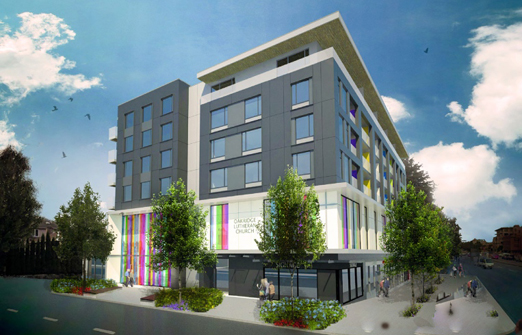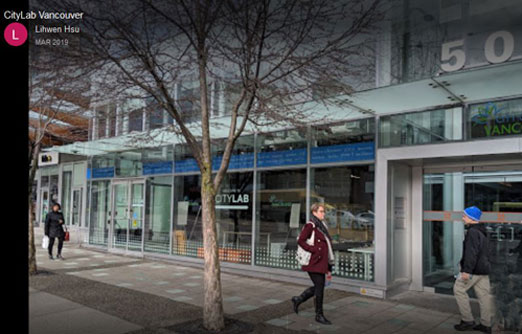
The Oakridge Lutheran Church affordable housing development | 5688 Ash Street, west of Cambie on 41st | a 6-storey, mixed-use building, retail at street level, a new church and community space on the 2nd floor, and four levels of affordable rental housing above the church | Occupancy, Autumn 2019 | Catalyst Community Developments Society
Working with the B.C. Assessment Authority, the Community Services Division within Vancouver City Hall’s Planning Department have identified 364 places of worship in the City of Vancouver that — with the assistance and co-operation of Vancouver City Council, and the provincial and the federal governments — could become prime development sites for the provision of seniors and affordable rental housing, and a plethora of community service spaces, including child care centres and seniors centres.

On Tuesday of this past week, representatives from almost every department at Vancouver City Hall met at CityLab, on the northwest corner of Cambie and West Broadway, with representatives from across Vancouver’s religious landscape, including Baptists, Catholics, Anglicans, Presbyterians, Buddists and Mennonites, as well as a representative cross-section of members of the Jewish, Islamic, Sikh, Salvation Army, Lutheran & United Churches across our city to continue a dialogue with Vancouver’s faith groups on the redevelopment potential of their places of worship.
Located on the Burrard Peninsula, with water surrounding two-thirds of our city’s urban landscape, development potential for affordable housing and community spaces is limited by the dearth of developable land on which to provide below market housing, and community services. Since the 1960s, the development ethos in our city has been “build up”, such that skyscrapers not only dot the landscape, in areas such as the West End and northeast False Creek almost smother Vancouver, all in service of densification, long our city’s informing planning & development buzzword.
With the growing shortage of community spaces on which to provide needed community services, such as child care centres — largely due to increasingly out-of-control development pressures, leading to skyrocketing land costs and increasing income inequality — the city is turning to faith groups across Vancouver to partner with the three levels of government to help alleviate economic disparity and our city’s unaffordable housing crisis.
The City, in partnering with the faith community, is looking not only to build low-cost and below market housing on lands owned by the places of worship, but partner with faith groups, as well, in providing community gardens and food programmes, community clinics (tax, ESL), addiction workshops and support services, job training, performance spaces, active living programmes & child care centres, in the hope of fostering community.
In Tuesday’s VanRamblings we’ll discuss the issues of declining membership in our city’s places of worship, the dilemma of aging infrastructure and the dearth of funds available for physical maintenance, and the attendant and inherent consequences places of worship face in attempting to fulfil their mandate of service not just to their membership, but to the community.
In Wednesday’s instalment of this week’s faith group / affordable housing / community services series, VanRamblings will explore the role of the Metro Vancouver Alliance, which has partnered with city staff and faith groups across our region — as well as with members of Metro Vancouver’s development community — towards the provision of affordable housing.
In addition, VanRamblings will seek to provide insight into why Vancouver’s underutilized places of worship may very well emerge as a critical component in our city’s plan to build community, to address income inequality and the attendant issues of access & succour encompassing the vast majority of our city’s socially and economically beleaguered residents.